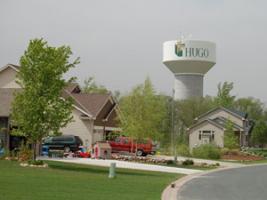
Audio
- Census: Gains in some MN cities, job losses take toll in others (feature audio)
More from MPR
Survey: Nearly 1 in 3 US Somalis live in MinnesotaDecember 14, 2010
FAQ: American Community Survey
December 14, 2010
New data to shed light on Minn. towns, big city neighborhoods
December 14, 2010
Services
Census: Gains in some MN cities, job losses take toll in others
by Ambar Espinoza, Minnesota Public RadioSt. Paul, Minn. — Demographers have forecast steady population growth for Minnesota for decades to come. But predictions that the growth will be uneven are evident in new data released from the U.S. Census this week.
According to the American Community Survey -- the Census Bureau's ongoing survey about U.S. residents -- some Minnesota communities are showing substantial population gains. At the same time, though, the new numbers show some cities have seen population declines, mainly as a result of job losses.
In Isanti, the population has more than doubled in the last decade, from 2,319 to more than 5833 residents, according to the survey. Isanti mayor George Wimmer said people are moving to Isanti for good deals on homes and land.
"They could buy a home in the city of Isanti for $50,000 to $100,000 less [than] an equivalent home in the suburbs of the Twin Cities," Wimmer said. "And so they added to the commute time, but they were able to get a lot more value for their housing dollar."
Wimmer said Isanti's new residents are also young families seeking a safe place to raise their children.
In Ostego, the population more than doubled, from 6,346 to 12,767.
"I would also say that our growth is generally people in their 30s and it is also almost always people with children," City Administrator Michael Robertson said.
The population growth has led Ostego to build more 3,149 housing units -- from single-family homes to senior housing and townhomes.
Robertson said the people who have made Otsego their new home are coming from the northwest portion of the Twin Cities metropolitan area, from places like Champlin, Ramsey, Plymouth, and Maple Grove.
DIVERSITY OF HOUSING
The city of Hugo also developed different types of housing that has attracted its new residents. City Administrator Mike Ericson said Hugo's population nearly doubled since he took the job in 2000.
Ericson said the city carefully planned and developed more than 600 acres that borders Lino Lakes.
"With that [growth] has come our goods and services like the daycare, grocery stores, dry cleaners, haircutting places, nail places, restaurants, the pharmacy," Ericson said "We didn't have any of that before I got here in 2000."
Ericson said another factor in Hugo's growth was the tremendous attention it gained from a 2008 tornado.
"People found out about this nice small town 20 minutes from St. Paul and the variety of houses that are here and housing opportunities here," he said. "We combine all of that with the small town rural character."
CAN GROWTH BE SUSTAINED?
State demographer Tom Gillaspy said the growth in Isanti, Ostego and Hugo fits patterns he's observed in counties just north of the Twin Cities area. But whether that grown can be sustained is uncertain.
"When the housing market recovers, will that outward expansion just simply pick up where it left off or has that come to an end and will people start moving back into the center? That's a question we can't answer yet," he said.
Carver and Scott counties southwest of the Twin Cities also are growing rapidly, Gillaspy said.
On the flipside, job losses and economic downturns pushed away residents in the Iron Range city of Hibbing.
"I think some of it has to do with automation in the mining business,' said City Administrator Brian Redshaw said. He said the mining industry became efficient and shed jobs.
"We don't need as many employees to work the mines as we did at one point," he said. "I know the peak population here was over 20,000 was back in 1970, I think."
Redshaw said industries that support mining have also left the area. He said it's been a constant battle to maintain industry that can employ a lot of people as companies often are lured elsewhere with tax incentives, faster internet connections and warmer temperatures.
Other northern Minnesota cities with population declines include International Falls and Virginia.

In The Spotlight
-
The Current Music Blog
Your daily note for good music, news and pop culture. With attempted jokes.



